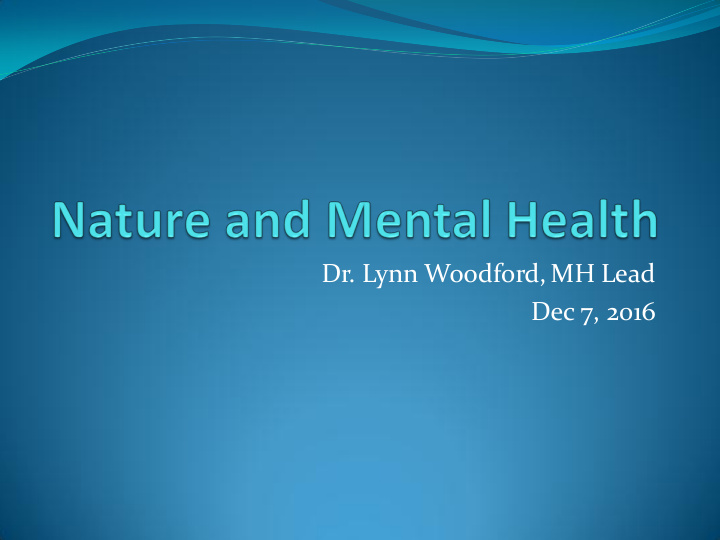



Dr. Lynn Woodford, MH Lead Dec 7, 2016
Nature and Mental Health 80% of Canadians live in urban settings Urban versus Rural Urban: 20 percent higher risk of anxiety disorders 40 percent higher risk of mood disorders as compared to people in rural areas.
Nature and Mental Health Is exposure to nature linked to positive mental health? What are nature’s impacts on emotion and mood? Can exposure to nature help “buffer” against depression?
Viewing Nature and Mental Health Viewing nature is positive for health Improves recovering from stress, improves concentration and productivity improves the psychological state, particularly of people in confined circumstances such as prisons, hospitals, and high-rise apartments/high-density living nature was most rehabilitative for those experiencing the highest levels of stress
Nature and Attention Walking in nature: Increased attention Increase effectiveness on tasks after Children with attention deficits (ADD/ADHD), 2008 study, Faber Taylor and Kuo compared the impacts on attention behaviours of children with ADHD who were taken Guided walks in three different outdoor areas: a park setting, a downtown area and a residential area. Improvements in attention behaviours were greater after the park experience.
Nature and Mental Health As for time in the outdoors, researchers from Nippon Medical School in Japan compared the effects of walking through a forest versus walking through a city. Results: decreased stress hormones increased the natural killer cells of the immune system and the expression of anti-cancer proteins.
Stanford Studies of Time in Nature Increase in positive mood Increase in cognitive function, including working memory, Decrease in anxiety. Supports the idea that exposure to natural greenspace can improve affect and cognition
Stanford Studies: Time in Nature Compared walking in nature with walking in an urban environment http://news.stanford.edu/2015/06/30/hiking-mental- health-063015/
Stanford Studies: Time in Nature Neural activity in the subgenual prefrontal cortex, a brain region active during rumination repetitive thought focused on negative emotions decreased among participants who walked in nature versus those who walked in an urban environment. These results suggest that accessible natural areas may be vital for mental health Help inform the growing movement worldwide to make cities more livable, and to make nature more accessible to all who live in them
Nature and Mental Health Study of different natural environments versus manmade environment: Improved both self-esteem Improved mood the presence of water generated greater effects Both men and women had similar improvements in self- esteem after green exercise Environment provides an important health service Even 5 minutes in nature can have an effect
Nature and Mental Health There is mounting evidence that contact with nature has significant positive impacts on mental health It is associated with: reduced levels of stress reduced levels of depression and anxiety increased resilience improved self-esteem increased capacity to engage socially
Nature and Mental Health The growing disconnection with our natural environment may be exacerbating the escalating rates of mental illness Mental health professionals should be prescribing time in nature High quality parks, gardens and nature reserves need to be accessible to all Engaging with nature may help to decrease mental health issues, especially among children
Ongoing Questions Frequency, Duration, Intensity of exposure required for benefit Specific effects on subgroups of the population, Children and youth Teachers Parents Long-term effects What are the essential requirements for, and the limits of, nature’s positive effect on mental health?
Links to articles http://www.mindingourbodies.ca/about_the_project/l iterature_reviews/the_nurture_of_nature http://www.takingcharge.csh.umn.edu/enhance-your- wellbeing/environment/nature-and-us/how-does- nature-impact-our-wellbeing http://news.stanford.edu/2015/06/30/hiking-mental- health-063015/ http://www.psychiatryadvisor.com/mood- disorders/nature-cognitive-anxiety-depression- mood/article/448018/3/
Recommend
More recommend